Autonomy and Counter-Power:
Organization After the Yellow Vests
ACTA
This text stems from a talk given by the French journal ACTA during an international congress organized by the Catalan magazine Catarsi in Barcelona last December. Now in its third iteration, the congress facilitates the exchange of intellectual reflection and militant experience between different countries, touching on themes such as unionism, urban struggles, the realities of fascism today, and the stakes of political communication in the digital age.
We take this opportunity to develop a report on the sequence of struggles in France and across the globe in recent months, considering both its novel characteristics and its strategic impasses. Our aim here is to place the question of organization back on the table, while also proposing a rough sketch of what the seemingly-obscure concept of victory might look like today.
—ACTA
Other languages: Français
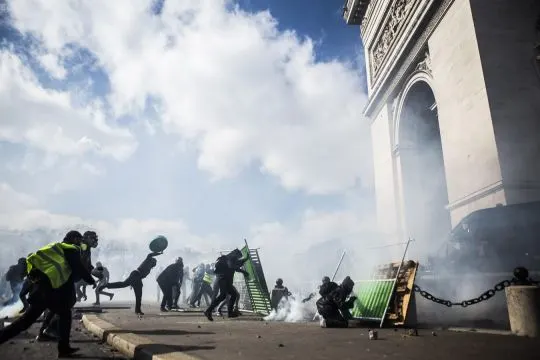
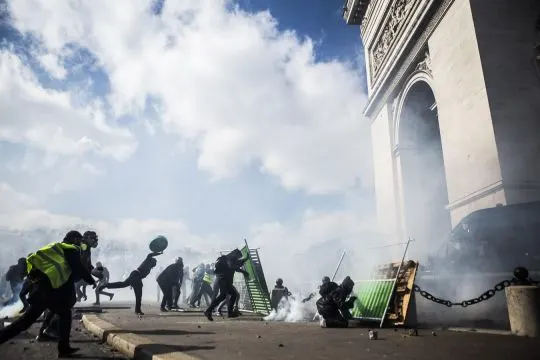
The year 2019 witnessed a new wave of uprisings on a planetary scale. Dozens of countries around the world watched as their cities erupted into violence, their economies were paralyzed, and the legitimacy of their governments was challenged in the streets. Despite obvious differences in context, the majority were popular mobilizations centering around common issues: worsening precarity, social regression and fiscal austerity – the result of several decades of unchecked liberalism. Added to this was the corruption of elites, the disrepute of the political class, and the authoritarianism of the State.
A common element in a majority of these cases is the collapse of institutional mediations. Many of these movements formed at arm’s length from parties and unions — when they were not openly hostile toward them. In France, the skepticism of the Yellow Vests toward any form of representation is evident to anyone, while the more recent movement against the proposed pension reforms has crystallized a tendency among the more combative union bases of acting autonomously from their bureaucratic leadership. We see this at several levels: for instance, in their decisive insistence on December 5th as a strike date, in their will to take control of how the strike will be handled (i.e. a “renewable” rather than a “pearled,” or slowdown, strike), in their experimentation with more conflictual forms of action, and in their refusal to obey calls for a truce (even when they emanate from trade federations themselves).
The Yellow Vests phenomenon casts a stark light upon a basic feature of our time, namely, that traditional representative bodies are no longer in a position to capture the energy of protest, let alone direct it. From here on out, those who face down the State are on their own. From Paris to Santiago, by way of Beirut, popular revolt is shattering the recognized frameworks of struggle, fleeing in every direction. At a planetary level, its principal weapons are the blockade and the riot.
While this reduction of the antagonism to two terms may in some cases safeguard the people against the betrayals and intrigues of politicians and the various other apparatuses, it is no less problematic when one considers its long-term consistency and its possible outcomes — we will return to this later.
To be sure, several of the recent movements have succeeded in winning tactical victories: the abandonment of the new taxes at the root of the revolts in France and Lebanon, the suspension of the public transport fare hikes and the promise of a constitutional referendum in Chile, the abandonment of the austerity plan in Ecuador, the withdrawal of the extradition bill in Hong Kong, the resignation of Bouteflika in Algeria, etc.
States everywhere have bowed to popular pressure. Yet, with the exception of a few, the movements have kept going beyond these tactical achievements, and still continue today. In fact, it is this continuation, precisely, which reveals a major difficulty that cuts across every struggle in the current period: we have no shared conception today of what a victory might be, at either a tactical or a strategic level. (Insofar as a victory, in our view, is always the inscription in history of a point of irreversibility.)
We cannot see clearly what victory looks like. For us, the concept of victory is obscure.
By contrast, the twentieth century had at its disposal a relatively clear understanding of victory, one widely accepted by revolutionaries throughout the world. To be victorious meant to seize State power. This was to be done either by classic electoral means or else through an armed insurrection. Those “progressive” formations that came to power by respecting the rules of bourgeois democracy wound up either abandoning any prospect of social transformation, under the weight of institutional constraints or because of the intrinsic corruption of state structures, or else they found themselves vulnerable and powerless in the face of the reaction of the propertied classes and their imperialist allies. As for the revolutionary seizure of state power, historical experience has shown that, by itself, it in no way guarantees a general advance toward communism and that, consequently, a successful insurrection alone cannot define the concept of victory. (In other words, we cannot remain satisfied with a strictly “military” definition of victory.)
But we have not yet been able to put forward a new concept of victory adequate to the novelty of the movements that have shaken the world in recent years and which have everywhere run up against the same strategic impasses.

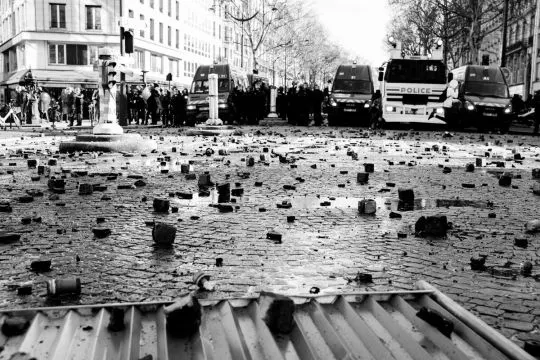
The question of victory is directly related to the question of organization. The determination of this or that hypothesis of victory leads us to adopt a certain type of organization adapted to the success of this hypothesis. Lenin’s theory of the vanguard party (endowed with military discipline and committed to the objective of taking state power) issues directly from his analysis of the failures of the revolutionary uprisings of the nineteenth century—foremost among them being the Paris Commune. Thus was he led to delineate a new type of political organization capable at last of leading the proletariat to victory. And if the Leninist party-form imposed itself as the canonical form of revolutionary organization during most of the 20th century, it is largely owing to the prestige derived from their 1917 victory. The hypothesis had, in a way, proven itself.
Designed for seizing state power, the Leninist party certainly showed its formidable insurrectional efficacy; however, it proved to be radically deficient in the exercise of this power when it came to the post-revolutionary phase and the achievement of the strategic objectives of communism. As Alain Badiou wrote, “The Leninist party is incommensurable to the tasks of the transition to communism, despite the fact that it is appropriate to those of a victorious insurrection.”
Throughout the 1970s, French Maoists and Italian autonomists had (among other things) counted the overcoming of the traditional Leninist paradigm among the essential tasks of the politics of emancipation. It is this problem that we have inherited today.
We cannot help but notice the general disorientation that runs through the whole of our camp on this issue. Whereas some have decided to sweep away the motif of organization completely, on the pretext that it is, in and of itself, synonymous with a mortifying alienation, others have been content to carry on with the ossified model of the avant-garde party. The former glorify the movement, and perhaps even pure movement itself, reducing their political practice to following each of its new figures. Although they often display remarkable tactical activism during sequences of acute conflictuality, their fetishization of an affinity-driven approach condemns them to retreating during non-movement periods. As for the latter, they remain rigidly loyal to obsolete organisational models, and this prevents them from truly entering into and becoming internal to the movements in question, leading to a growing disconnect with the new dynamics of struggle.
We believe that the problem of organization is once again an open question, one that demands to be taken up anew by revolutionaries. The Yellow Vests movement has been a formidable testing ground for the relationship between mass movement and organized subjectivity. For us, one of the essential lessons of this sequence is that activists must be in the movement “like fish in the water.” They must be truly internal, that is, actually in the movement. This means participating in its basic assemblies, establishing connections with its local groups, carrying out investigations, upholding its main deadlines, and allowing the novelty of its forms of struggle to “contaminate” them—in short, putting themselves in the school of the masses. They cannot remain content with a posture of exteriority, or even worse, of scorn, which was something too many leftists fell into at the onset of the 2018 winter uprising. As Marx put it in the Manifesto: “Communists everywhere support every revolutionary movement against the existing social and political order.” That being said, however, the position of revolutionary militants cannot be purely one of tailing or following along [suivisme], for it is not merely a question of accompanying the movement, or even of disappearing into it, but of intervening in it politically.

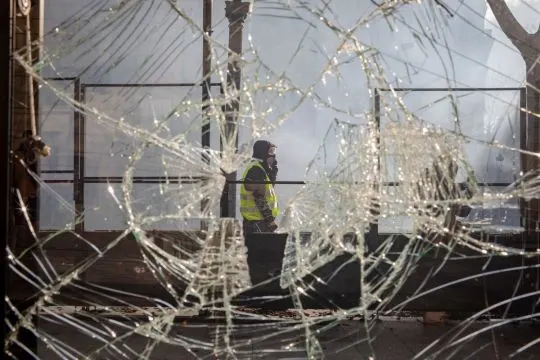
This brings us to the fundamental point: political intervention always leads to a division. What unites a movement, especially at the beginning, has a negative dimension: different sections of the people come together in common opposition to a particular government, a particular bill, a particular aspect of the dominant order. The follower mentality treats this unity as something to be preserved at all costs and regards any effort to introduce political divisions as tending to weaken the movement itself. On the contrary, we believe that the negative unity of a movement always covers up important (sometimes even antagonistic) contradictions and that it is precisely the role of revolutionaries to intervene where these contradictions exist—and thus, to accept the division. For it is only through this work of division that true, affirmative unity can be built.
This kind of work has been undertaken within the Yellow Vests movement, for example around the question of antifascism. There is no doubt that the presence of the extreme right, whether in terms of diffuse reactionary opinion or the violent activism of small groups, was notable at the beginning of the movement. Nationalist, neo-fascist, or Pétainist formations felt comfortable enough to unfurl their banners at the Étoile roundabout, to strut down the Champs-Élysées, to beat up leftist activists—until the brutal attack on an NPA contingent on 26 January 2019. The organization of an explicit antifascist response made it possible to rout these nationalist groupuscules, which were de facto excluded from the marches. At a deeper level, the early construction of an antiracist front bringing together organizations based in working-class neighborhoods such as the Adama Committee, local Yellow Vests groups, and various autonomous collectives allowed the contradictions of the movement to be worked on politically, helping to develop its watchwords and thereby gradually marginalizing its reactionary component.
It is also clear that the movement’s political maturation process was accelerated by an early collective experience of police and judicial repression (that is, of State authoritarianism) at levels that had previously been reserved exclusively for the racialized populations of working-class neighborhoods—yet which have now become the default mode of repression meted out to the entire social movement.
We argue that the task of organized militants during a movement is not only to provide tactical support for mass action but also to carry out a properly political intervention within the movement, which in most cases will entail a deepening of a certain number of its internal contradictions.
But if the organized must be sensitive to the irruptions of events (rather than obsessing over the maintenance and reproduction of their own organized process), getting organized does bring with it a duration proper to revolts by crystallizing their most advanced political contents. This other sense of time is what allows organized revolutionaries to continue the political work even in sequences of low conflictuality. They get organized by taking root in a territory; by opening and running accessible, public spaces; by establishing durable structures, spaces for self-education, and tools for propaganda and debate; and by deepening theoretical elaborations—in short, by practicing a militant program.
As Marx observed, since they capable of imagining the next stage of the political process, communists are not satisfied with following the pure present of revolts. In particular, they cannot be satisfied with a succession of tactical gestures (however spectacular) lacking any strategic interrelation. Here again we have detected a recurring weakness: although we, in France, have been living in a period of exceptional and almost uninterrupted social conflictuality since 2016, we have observed the fragmentation and the inconsistency of revolutionary organizations. A short-sighted “movement-ism” seems to be preventing any long-term recomposition.

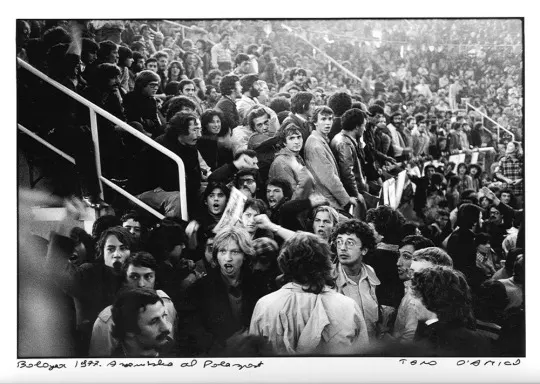
The Yellow Vests movement has confirmed this: any politics of emancipation is today practiced at a distance from the State and its institutions. As a result, any organized process committed to emancipation can only be autonomous. The Yellow Vests have learned to rely on their own forces, they did not need any trade union or any political party to bring about a level of social antagonism unseen for over half a century. To borrow from Negri in his 1977 text, Capitalist Domination and Working Class Sabotage, it could be said that they combined a political destabilization of the regime (through the Saturday insurrectional riots) with the material destructuring of the system (through logistic blockades, the occupation of roundabouts and their territorial spread). Albeit in a fragmentary and incomplete way, they practiced larval forms of a popular counter-power.
This brings us back to the strategic considerations set out above. What do we mean by “counter-power?” Counter-power is the preliminary form of autonomy: it is both “liberated space,” a field of experimentation prefigurative of all other social relations, and “conflict zone,” a particular point where the reproduction of social command is blocked. Here positivity cannot be dissociated from negativity, nor creation from antagonism. For “the latencies of the future contained in the present are not limited to existing in ideological representations and political programs. On the contrary, they already manifest themselves in the eruption of the revolutionary process, externalizing themselves in the most surprising and unexpected configurations made possible by the successive puncturing of the dominant forms of relations,” as Curcio and Franceschini wrote in their 1982 text, Drops of S__unlight in the C__ity of S__pecters.
To the extent that we must do away with the idea that nothing is possible prior to the conquest of central power; to the extent that the decline of the State must become not only an historical horizon but a principle visible in the present through political action itself—to this extent, counter-power is today the elementary reality of any emancipation process.
(France dotted with “yellow communes”—those occupied roundabouts and other innumerable pockets of self-organization which, in addition to the metropolitan riots, allowed thousands of proletarians to rediscover the meaning of fraternity while also laying the material conditions for a mass economic blockade—the France of last winter was undoubtedly a life-size approximation of this process of constituting, from below, an other power, a popular power that sets up its own institutions).
Whether one looks to the ZAD of Notre-Dame-des-Landes, or to the Yellow Vests themselves, recent experience shows that any dynamic of counter-power must confront the problem of self-defense and of protecting this counter-power. This issue is all the more pressing in the context of an authoritarian turn by the State whose repressive methods have become increasingly unhinged. We must likewise consider the possible forms in which a strategic (and not only tactical) negativity might be exercised—one committed to the destruction of bourgeois law, that foundation of the dominant order, a destruction that the capillary expansion of counter-power alone cannot ensure.
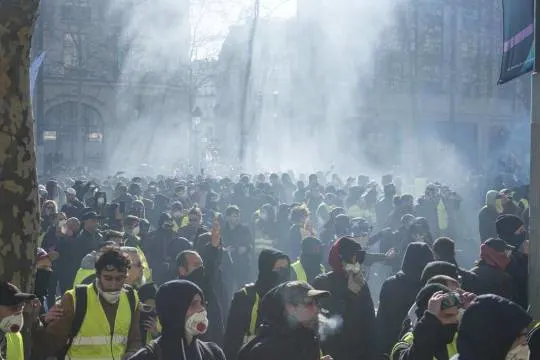
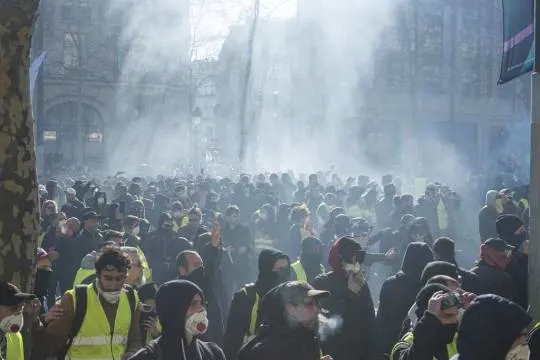
What then are the stakes of putting the question of organization back on the agenda? It is clear that only historical practice will allow us to make real progress on this issue. And that theoretical elaboration can only serve—but this is already a lot—to formulate problems.
We must get organized in the field of self-defense, which likewise determines offensive capacity. In this sense, to borrow an intuition from Tronti, it is a tactical function of mass antagonism. For, as we have said, the accumulation of popular power necessarily runs up against the “prohibitive power” of the State. Once it reaches a certain threshold of strength and temporal consistency, every emancipatory experiment confronts this “prohibitive power” that puts its very survival at stake. To envisage this as a linear process would be the height of naivety. Here is precisely where the role of organized political subjectivity lies: to “remove the obstacles” that oppose the growth of popular power, to break up the enemy’s command structure: “to strip capitalist domination of its hope, its possibility of a future,” as Scalzone put it in 1978. It is unclear, otherwise, how the emancipatory elements that developed “in the womb of the old society” could ever in fact be actualized, ratified, and generalized.
But this function alone does not exhaust the issue. Another essential aspect of any organizational process is its multiplicity. It cannot be “one dimensional.” This was, moreover, the principal error of the fighting formations in the 1970s cycle: the military function ended up absorbing all the others, reducing the specter of political practice to this one partial dimension. On the contrary, the organized must seek to combine and articulate different forms of struggle, different terrains, and different modes of intervention. As one agent of the Imaginary Party pointed out, “People forget, but the party has always been both legal and illegal, visible and invisible, public and conspiratorial.” Its richness and potentiality reside in this plurality.
Organization must therefore also take on the role of political recomposition. Today, there are a variety of trajectories of struggle in the movement that act on specific terrains and claim relative autonomy. This is the case, for example, of feminist and antiracist movements (which are themselves traversed by major fault lines). The question of organization, at present, is therefore just as much a question of organizations. Hence the motif of the front that has been circulating recently, which is one possible form that this recomposition could take. What would be at issue is a space necessarily open to internal contradictions, within which revolutionary militants would have the task of working toward a determinate programmatic synthesis: to foster connections between centers of struggle and different social subjectivities, to thwart the risk of paralysis or fragmentation by affirming a communist projectuality as an evaluative criterion for real situations.
Since 2016, and more intensely in recent months, egalitarian alliances have been formed between combative union chapters, autonomous collectives, local Yellow Vests groups, working-class neighborhood organizations, radicalized ecological militants, and high school bases — our task today is to ensure that these alliances survive beyond mere movement temporalities, that is, to build a space of organization and coordination that might create the bases for a new type of popular unity.
Translated by J.R. and Ill Will Editions
Photo credits: Maxwell Aurélien James, for the Collectif ŒIL